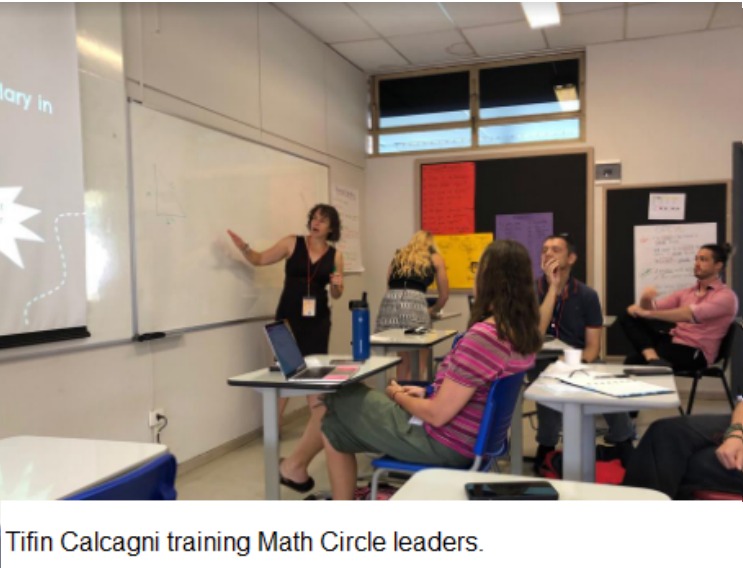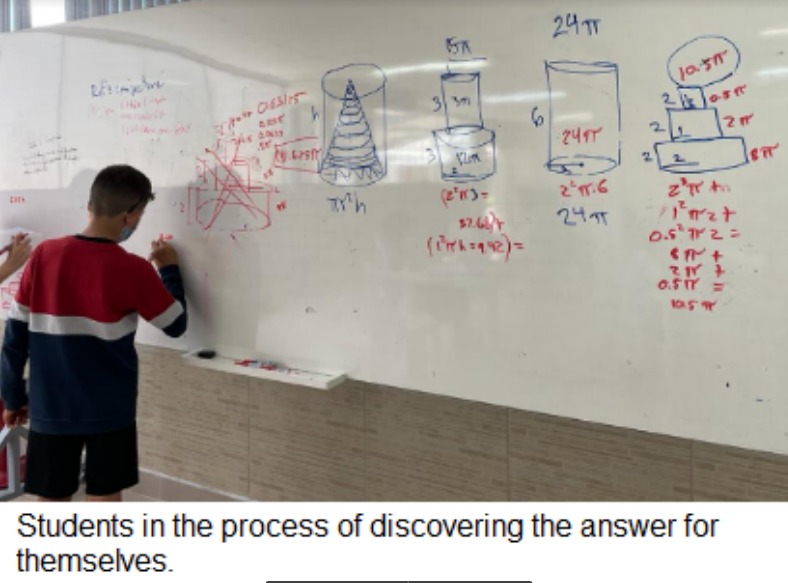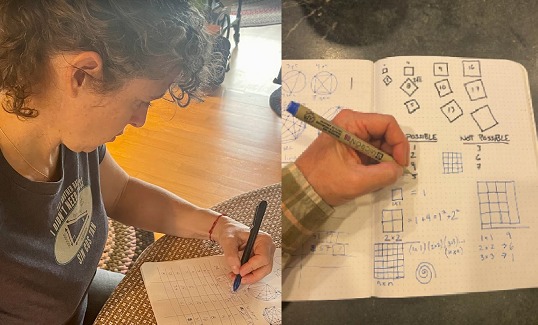By Milan Sime Martinic
The students at the Escola Americana de Brasilia come to speak to their teacher Tifin Calcagni for help with math problems. She provides no answers but asks questions that lead the students to carve a path to the answer.
Mistakes will be made, explains Calcagni; they will go down the wrong rabbit hole, but they will discover the singular enchantment of mathematics. It is a radical new concept in teaching mathematics. She is training her students to think through uncertainty to discovery without being told how to it or to follow what someone else did.
There is real ownership in those discoveries, and more permanent memory is the philosophy behind the Global Math Circles program, a global non-profit dedicated to bringing mathematics and discovery into a joyful learning experience, and Calcagni is training leaders in Brazil and the world over to lead classes designed to tame through absolutism to a personally authentic approach to mathematics.

But how do you achieve knowledge without showing the way to the answer? It is wisdom that they acquire; Calcagni tells how it goes:
-I do not understand fractions.
How old are you?
-Nine.
And six months ago?
-Eight-and-a-half.
And just like that, the nine-year-old understood fractions.
Calcagni is filling the downtime in the middle of a meeting, drawing circles, and connecting dots. She is in another world, a world of numbers, deep in thought, working on a problem that kept her awake the night before, on unlocking the secrets in patterns before her.
At that moment, she is where we are when we are around other people but together with no one but ourselves. Except she is not alone. She is in a world that transcends the numbers and patterns in front of her and opens into a larger enrichment of the human experience.
She is a brilliant mathematical mind but is convinced that mathematics is within everyone’s reach, and she is out to make mathematics something that people enjoy and where their work with numbers can seem just as brilliant. She is a teacher by training but hear her talk about mathematics, and it is almost like hearing poetry for the first time, well, the mathematical version of it.
There is beauty in it and clearly a joy that draws Calcagni back to the numbers and to dedicate herself to bringing that joy to children and to everyone. In teaching and in mathematics, she is someone to watch.
“Math is a beautiful thing, and it gives us a framework for understanding and appreciating beauty in other realms,” said Calcagni. “It sounds ambitious, but my hope is that it will make kids’ lives more pleasurable and fulfilling, whatever they end up doing.”
Calcagni is stouthearted enough to take her numerical skills beyond tackling a series of fundamental problems to taking children just finding their feet in the world of mathematics along the journey of mathematical discovery that she is clearly enjoying in her own life.
She is doing this as a teacher and as the driving force behind the Global Math Circle program, a pioneering project reaching children from India to Brazil to America and open to children the world over.
The Global Math Circle (www.theglobalmathcircle.org), o Circulo da Matemática in Brazil, (www.ocirculodamatematica.com.br) can be distilled to its maxim, “Tell me, and I forget. Ask me and I discover.” Literally, a different approach to teaching math, not by directing or showing but by asking questions that lead to discovery. There is no standard grading system, and the teachers follow the maxim quite strictly, asking, not telling.
“Curiosity is always a finer spur than rivalry,” explains Calcagni. “We do not diminish the students’ discoveries by reciting the famous names of those who had gone this way before. Mathematics is our universal language — but each of us learns to make our own.”
“Discover mathematics as mathematicians do, starting from nothing but an accessible mystery,” says the program’s site. “Experience mathematics as a poetry of the mind.” The Global Math Circle is an empowering approach to making sense of numbers and the universe, and beautiful concepts.
“If I ask someone to imagine a math class, I think the general image would be a teacher standing in front of a board, showing students how to solve problems of different kinds,” explains Calcagni. “But in a math circle, the teachers don’t tell the students how to solve anything. The teacher, or ‘leader,’ simply presents the problem and records the thoughts of the participants.”
Mathematics is to be understood and discovered, says Calcagni. “Discovering patterns and finding where they lead.”
That results in discovering mathematics instead of memorizing it, she adds. “When kids discover and explore mathematics, not only is it more fun, but it leads to a deeper level of understanding and an ability to think mathematically. Kids who learn this way are more willing to try to solve problems that they don’t initially understand.”
“This does not sound like the average math lesson because what most schools teach is not what mathematicians do. Mathematicians do not repeat the same technique twenty times; they play with problems, they discuss them, they explore side-branches, they make mistakes,” says the Global Math Circle.
For the next year Calcagni will be leading Math Circles in “coaching and supporting circle leaders, training circle leaders, developing resources for circle leaders, and supporting schools and after school programs who want to implement math circles into their programs.”
It is work that matters. Math that inspires.

For Calcagni it is the result of a personal journey in both teaching and mathematics. She is a teacher and a world citizen who has taught in Brazil, Kazakhstan, Tunisia, Switzerland, Canada, and the US.
Her involvement with Math Circles began when trying to improve her teaching tools and contacted Robert and Ellen Kaplan, Harvard teachers, authors, and founders of the Math Circles approach, after buying Robert’s book “Out of the Labyrinth: Setting Mathematics Free,” and being impressed with their system that made of math a playful, joyful search. The Global Math Circle was set up as a global non-profit organization.
When the Kaplans took the Global Math Circle program online, it was Calcagni by their side, the three of them teaching math circles.
“But the demand for circles was more than the three of us could provide, so Bob started bringing on Ph.D. candidates to do outreach with us,” Calcagni tells the story of the beginning of the Global Math Circle program.
“These amazing mathematicians had very creative plans for classes,” she said, noting that pandemic struggles created some difficulties which lost some of the leaders.
But after Google invited Kaplan to do a recorded demo for children, Calcagni says that some Google employees joined the Global Math Circle board and upgraded its systems. “They started recording all of the sessions, so now I could watch what leaders do and give feedback on what actually happened, not what they said.”
For the next year be expanding the global program, training, and coaching circle leaders, developing resources, and supporting schools and after school programs who want to implement math circles into their curricula.
“Everyone is a math person,” is Calcagni’s message and mission. “Math can be learned, just like anything else. It’s not for the gifted or privileged or those with a specific type of brain. Whatever I can do to spread this message and show teachers how to explore mathematics with kids, I will do.”
Exploring prime numbers can stump even practiced mathematicians, but Calcagni’s mind and pedagogic approach provide a glimpse into the value of the Math Circles approach she heads.
Let’s start with rectangles, she says, and explains how taking a different number of square blocks can make rectangles by aligning one square next to the others in a straight line.
Then she points out that a set of four blocks can be stacked to make a rectangle, say 2 blocks on top and two at the bottom, making a four-block square. Then she questions, which numbers of blocks can make more than one rectangle?
Math Circle participants, she says, will, with a bit of exploration, notice that every even number over two can do this, and so can any multiple of 5. Math Circle kids will quickly discover that any multiple of any number will be able to make more than one rectangle. The prime numbers make only one rectangle. It is these patterns that hold the answer on how to find the prime numbers.
It is finding those patterns that develops that sense of discovery that makes more impact on the mind, she says, than the memorization that is standard in classrooms around the world.
“Young kids explore mathematical ideas all the time,” says Calcagni. “They love counting, grouping, exploring patterns, and playing games. Kids learn that if they do not think the same way as the teacher, if they cannot quickly and efficiently apply an algorithm in the correct situation, that they are not a ‘math person’.”
That is not at all true, she said.

It is learning to think creatively about patterns that is important in understanding mathematics, she explains. Algorithms are secondary, and not important at all. But mathematics in schools has been reduced to this, and it’s all kids are taught is important. This may be true for a computer, but not for a person.
“We can, however, unlearn that memorizing algorithms is important, and kids can easily start exploring again, when given the chance. And if presented with the correct level of problem in a non-competitive, accepting environment, they often do.”
And that is the beauty, and the genius, and the value of the Math Circles approach. Your children can learn math by discovery and be good at it and learn the lessons without memorizing.
In the real world, the solution to a problem is hardly ever obvious, says Calcagni, so the process of reaching the solution is itself a series of questions and answers, of guesses and doubts. It is a real lesson for all of us, kids, and adults, she said.
“If you can think flexibly, maintain several possibilities at once, listen and respond, you can all move forward to a solution that may be a surprise to everyone. And it’s fun.”
The process of mathematical exploration starts with a question.
“How many vertices does a 10-dimensional cube have?” asks Calcagni. “Can you tile a rectangle with non-congruent squares? What pattern do you see? Can you draw a path through this figure without going through any parts twice? Can you tile a chessboard with dominoes?”
Then you let kids play, she says of the Math Circles approach. “Math is exciting, not scary. The harder the problem, the more they want to understand it.
Calcagni imagines a world where math is not the gatekeeper for kids who want to pursue their dreams, where they feel confident enough to try. “A world where failure is exciting because it leads to new understandings and new ways of thinking.”
The Global Math Circle trains teachers on the art of guiding shared discovery and has students in India working alongside students in other parts of the world. It accepts children of all ages and offers scholarships based solely on financial needs. Its work extends to communities and countries that see the value of this approach to discovering mathematics.
It is the Math Circles’ vision and Calcagni’s goal to see a world where math is everyone’s favorite subject, to see schools where kids are excited to work together to discover the mysteries and secrets of the universe.
“Together, we can reveal the secrets of something that, individually, we thought was unknowable,” concludes Calcagni. “And I feel very fortunate to have been given this opportunity.”
Organizations interested in signing up for the Global Circles non-profit Training Institute can write to: [email protected]

